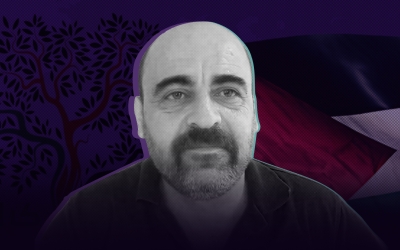A Brief Colonial History Of Ceylon(SriLanka)
Sri Lanka: One Island Two Nations
A Brief Colonial History Of Ceylon(SriLanka)
Sri Lanka: One Island Two Nations
(Full Story)
Search This Blog
Back to 500BC.
==========================
Thiranjala Weerasinghe sj.- One Island Two Nations
?????????????????????????????????????????????????Wednesday, June 30, 2021
Hollow justice of the settler state

A Palestinian woman stands in a bedroom ransacked by Israeli soldiers during a night raid on her home in Balata refugee camp in the West Bank city of Nablus in January 2017.
Ahmad Al-BazzActiveStillsMaureen Clare Murphy -28 June 2021
When Mohammed El-Kurd said that “living in Palestine is like having a policeman in your bed,” he wasn’t employing a rhetorical device or a figure of speech. The analogy is too close to reality to be a simile or metaphor.
El-Kurd would know – his family faces imminent displacement from their home so Jewish settlers can occupy their bedrooms in the Sheikh Jarrah neighborhood of Jerusalem.
Removing the indigenous population from their homes and lands so they may be replaced by foreign Jewish settlers is the central principle guiding the Zionist project in Palestine since before the Israeli state was declared in 1948 until today.
Israel’s high court is due to hold a hearing on the fate of the El-Kurd family and other Sheikh Jarrah residents facing removal from their homes on 2 August.
There is little reason to expect they will be treated fairly by the court, which typically rubber-stamps any military or other state practice that advances Israeli subjugation of Palestinians and colonization of their land.
Rubber-stamping war crimes
Last week the high court upheld a decision to destroy a home belonging to the family of Muntasir Shalabi, a detained Palestinian accused of carrying out a drive-by shooting that killed an Israeli and wounded two others last month.
The home slated for demolition, in the village of Turmus Ayya in the central occupied West Bank, is inhabited by Shalabi’s estranged wife and their children. All of them have US citizenship.
Punitive home demolitions are a form of collective punishment – a war crime against Palestinians living under Israeli military occupation – and one long championed by the high court.
Israel’s judicial system as a whole exists to provide a liberal and democratic facade to a brutal settler-colonial regime.
Palestinians are generally unable to seek remedy in Israeli courts but occasionally human rights advocates have, with much effort and persistence, won victories challenging the practices of the military occupation within this hostile system.
One such practice is Israeli night raids on Palestinian homes in the West Bank for the purported purpose of “intelligence mapping.”
This procedure unfolds with a bang on the front door of a Palestinian home and waking up the entire family, who are ordered by heavily armed and masked soldiers to gather in a single room.
The invading soldiers inspect and record everyone in the household’s ID cards and telephone numbers, as well as how the residents are related.
Meanwhile, soldiers go from room to room, ordering one of the members of the household to open closet doors and lift up mattresses before leaving and moving on to the next home.
Psychological warfare
“A policeman in your bed” is too close to reality to function as an analogy when a foreign occupation military violates the sanctity and privacy of families’ homes without a court order for no other purpose but to assert Israeli control over every aspect of Palestinian lives.
The mapping procedure is a form of psychological warfare, as the journalist Jonathan Cook explains, intended to deny Palestinians the feeling of security even in their bedrooms.
The practice was challenged at Israel’s high court by Yesh Din and Physicians for Human Rights Israel, along with six Palestinians, who petitioned for a ban on raids on Palestinian homes except by court order.
Faced with a high court instruction “to be prepared for the possibility it will have to present the wording of the order,” the military amended it so as to avoid making its details public, the Israeli daily Haaretz reported earlier this month.
However, a loophole permits the procedure in “exceptional circumstances,” which Israel will surely exploit.
As Cook adds, given that the procedure targets families not suspected of any offense, “it is difficult to imagine what ‘exceptional circumstances’ could ever justify these degrading and terrifying raids.”
Israel will continue to raid Palestinian homes throughout the West Bank on a nightly basis under different pretexts.
The director of Yesh Din recently said during a conference at the Knesset, Israel’s parliament, that the mapping procedure represents only a fraction of raids on Palestinian homes.
Israeli occupation forces carried out some 130 arrest operations in the West Bank, excluding East Jerusalem, during the first two weeks of June alone. By the army’s own admission, most arrest operations are carried out at night, between the hours of midnight and 5 am.
“Imagine what it’s like to have your home, your bedroom, entered into every few months,” Muhammad Asfur, a Palestinian man from the West Bank town of Sinjil, testified to Yesh Din. “Instead of the home being our safe, protected space, it has become insecure.”
Breaking the Silence, a group of whistle-blowing Israeli military veterans, said that the true purpose of the mapping procedure is not to gather data but “to constantly remind the Palestinians living under occupation that we’re in charge, and we have the right and ability to enter their houses whenever we want.”
It is difficult to overstate the psychological harm caused by Israeli night raids on Palestinian homes.
Those harms were described in detail in a report published by Breaking the Silence, Yesh Din and Physicians for Human Rights Israel last year.
Parents described to researchers “a deep sense of helplessness” and an inability to reestablish a sense of safety in the home.
This sense of loss of control can lead to disinterest in planning for the future.
Meanwhile, as the report states, hyperarousal is “a typical reaction to trauma,” causing victims’ bodies to be on “constant alert,” making it difficult to relax and disrupting sleep.
“When prolonged, these disruptions could take a heavy toll on physical and mental well-being,” the report adds.
The psychological burden is especially heavy for children, potentially disrupting their development. Parents told researchers that they witnessed “behavioral or emotional changes in their children after the invasion of the family home.”
Terrorization is the point
These are normal responses to an abnormal reality resulting from Israeli policy that injures the very core of Palestinian lives.
“The invasion of private space may also destabilize the connection family members have to the home … a safe haven that symbolizes family and the protection of which is culturally and socially valued,” the report states.
The terror inflicted by Israel on Palestinians is not an unintended and unfortunate consequence of military operations necessitated by security.
It’s a strategy that has been central to the Zionist colonization project in Palestine, even before the declaration of the Israeli state. Uniformed forces and violent settlers terrorize and make life a living hell for Palestinians to get them to give up their homes and land.
Meanwhile, Israel’s high court goes through the motions of hollow justice as soldiers and police traumatize Palestinians in their bedrooms, inflicting trauma on one generation after another.
Complicity and accountability in Banat's killing
![A girl stands behind posters depicting late Palestinian human rights activist Nizar Banat during a demonstration in remembrance of him in Gaza City on June 29, 2021 [MOHAMMED ABED/AFP via Getty Images]](https://i1.wp.com/www.middleeastmonitor.com/wp-content/uploads/2021/06/GettyImages-1233712949-scaled-e1624973416456.jpg?resize=1200%2C800&quality=85&strip=all&zoom=1&ssl=1) |
A girl stands behind posters depicting late Palestinian human rights activist Nizar Banat during a demonstration in remembrance of him in Gaza City on June 29, 2021 [MOHAMMED ABED/AFP via Getty Images]
In the international community's narrative of illusory state-building in Palestine, the Palestinian Authority's security services are dissociated from violence. Whether such violence is meted out according to PA Leader Mahmoud Abbas's directives, or in terms of security coordination with Israel, the EU and the US prefer to retain a distant approach and one that is deeply rooted in the dynamics of the two-state paradigm. Never mind that the EU and the US are directly funding and training the PA's security services to turn against Palestinian civilians.
The killing of Nizar Banat at the hands of the PA's security services last week ignited protests across the occupied West Bank. Simmering beneath the immediate protests is the Palestinian people's awareness of security coordination with Israel, treacherous collaboration with Israel's colonial violence that has targeted Palestinians with dissenting voices or involved in resistance activities. At a time when Abbas is descending into a chaos of his own making, notably his refusal to hold democratic elections, Palestinians are protesting against the intricate web of violence which has so far sustained his "authority".![Why did the PA kill Nizar Banat? - Cartoon [Sabaaneh/MiddleEastMonitor]](https://i2.wp.com/www.middleeastmonitor.com/wp-content/uploads/2021/06/Cartoon-2.jpg?resize=476%2C333&quality=85&strip=all&zoom=1&ssl=1) |
Why did the PA kill Nizar Banat? – Cartoon [Sabaaneh/MiddleEastMonitor]
US State Department Spokesman Ned Price's statement is indicative of how Washington absolves itself of any role in creating the PA's security services and their violence. "We have serious concerns about Palestinian Authority restrictions on the exercise of freedom of expression by Palestinians and harassment of civil society activists and organisations," said Price. Anyone else for dodgeball?
However, the US exhibits no concern whatsoever that it trains the PA's security services to commit acts which lead to the murder of Palestinian civilians. Once again, Palestinian lives are expendable in view of the international commitment, to which the US is bound by consensus, to keeping the Palestinian people tethered to the two-state compromise, and protecting the occupation, apartheid state.
The EU's statement recognised the PA's "increasingly persistence practice" of targeting its opponents, yet it hesitated to describe Banat's death as politically motivated. "Apparently" allows the PA to remain on the EU's agenda, for no other reason than the two-state compromise and the humanitarian agenda forced upon the Palestinian people. In this context, how can the EU's calls for there to be accountability for Banat's killing have any meaning?
OPINION: The puppet authority is killing the Palestinians
If scrutiny is projected onto the donors, namely the EU and the US, an additional process of accountability must be taken into consideration; one that calls into question the Oslo Accords, the two-state compromise, and the international oppression which forced Palestinians to bend under PA rule.
In November 2020, Banat was arrested for a video denouncing the PA's resumption of security coordination with Israel, a betrayal by the PA at the news that Joe Biden had won the US presidential election. Security coordination, therefore, is the main issue. Banat's dissent threatened what remains of the PA's repressive power. Without security coordination, the PA risks political dissolution and accountability. These are two truths that it tries to stave off, even as Palestinians are clearly more emboldened in their protests and less willing to fit within the parameters imposed by the international community in its quest to legitimise Abbas, despite the clear illegitimacy of his political position and absence of a mandate to govern.
The views expressed in this article belong to the author and do not necessarily reflect the editorial policy of Middle East Monitor.
Nizar Banat killing: Witnesses recount Palestinian Authority's violent crackdown on protests
PA security forces stand accused of deliberately targeting journalists, rights groups observers and women during protests for the death of activist Nizar Banat
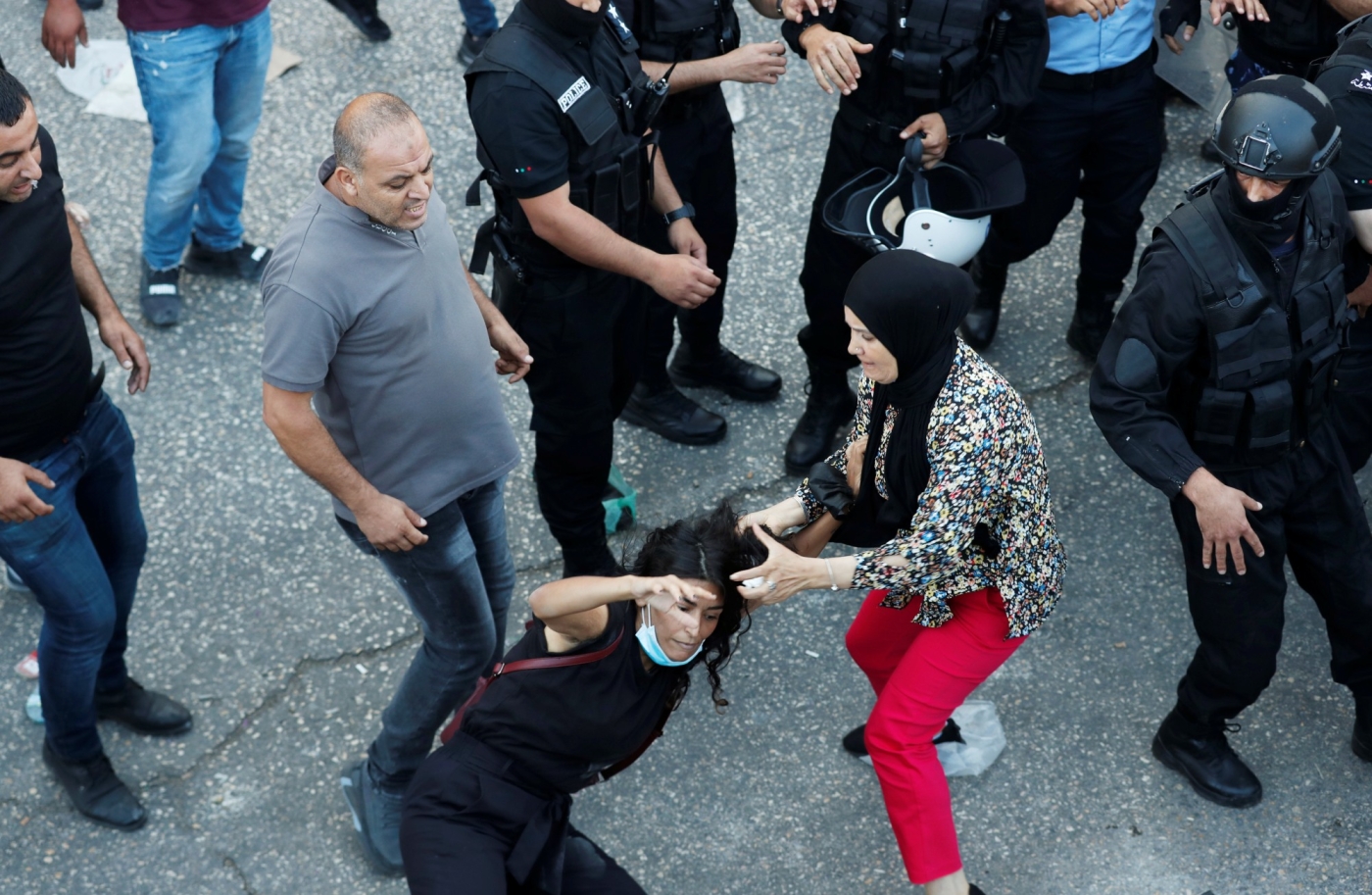 |
A demonstrator falls to the ground during a scuffle with a Palestinian police officer on 26 June 2021 during protests over the death of Nizar Banat, in Ramallah in the Israeli-occupied West Bank (Reuters)
By Shatha Hammad- 29 June 2021
The death of Nizar Banat, a prominent critic of the Palestinian Authority (PA), while in the custody of PA security forces last week, sent a shockwave among Palestinians and ignited widespread anger against President Mahmoud Abbas.
For five days, thousands marched in Ramallah, Hebron, Bethlehem and other occupied West Bank cities, demanding justice for Banat and calling for the overthrow of the PA.
The protests were met with a security crackdown that peaked on Sunday, according to eyewitnesses, with Palestinian security forces attacking demonstrators, beating journalists and deliberately targeting women and human rights workers.
"We stood there shocked at what was happening," Giusara Nakhleh, an eyewitness, told Middle East Eye. "We were watching horrific scenes of young men and women being dragged and beaten."
Nakhleh, who was standing near the protests in Ramallah on Sunday, said that she saw some 30 security officers in plainclothes attacking a protester, severely beating him as the young man tried to reach a safe area.
"When he reached the safe area where we were standing, they started beating us all," Nakhleh said.
"I was physically harassed and could not defend myself," she said. "I don't know how many were assaulting me, in addition to the insults and obscene language they used."
The incident, far from isolated, showed a troubling pattern of deliberate violence levied by Palestinian security forces in the face of popular discontent.
Two days of violence
The crackdown by PA security and intelligence officers was particularly violent in Ramallah, the administrative capital of the PA.
On Saturday, riot police and undercover officers violently dispersed a march heading towards the Muqataa - a guarded compound housing several government buildings, including the president’s office.
Plainclothes officers spread out among protesters, beating and dragging several people on the ground.
As protesters approached the intersection leading to the Muqataa, riot police launched a heavy barrage of tear gas and sound grenades into the crowd.
At least four journalists reported being deliberately attacked and assaulted.
On Sunday, the crackdown escalated, with the complete withdrawal of riot police from the city centre.
In their stead, counter-rallies in support of Abbas took place, while dozens of undercover officers, mostly masked and wearing black, intensified their attacks on demonstrators.
Protesters were attacked with batons and pepper spray, and phones were seized from people trying to document the crackdown.
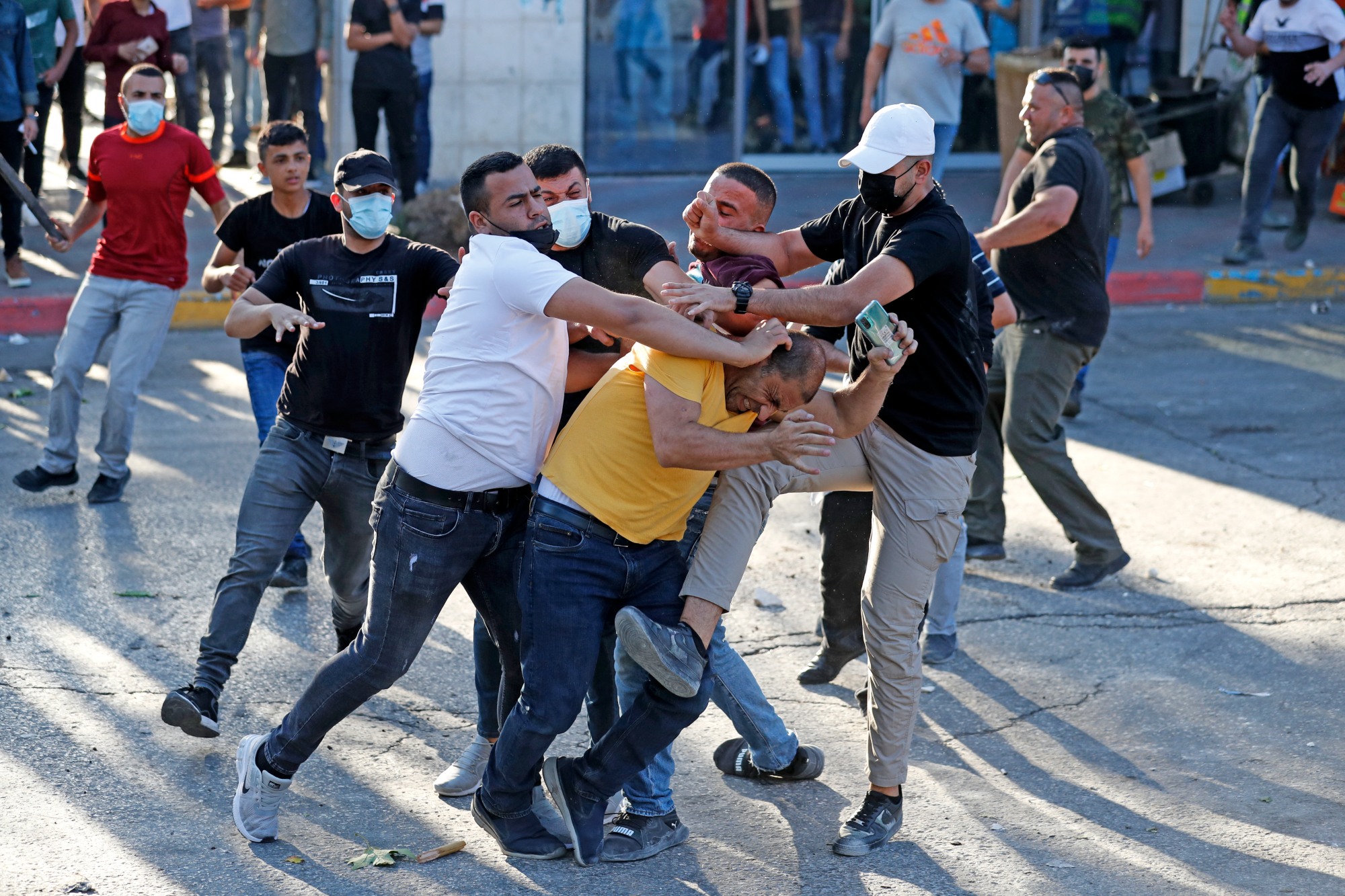
Attacks on media
Attacks on media crews, especially women journalists, were a prominent feature over the two days.
Plainclothes officers threatened and surrounded press crews near Ramallah’s clock tower roundabout on Saturday, preventing them from moving closer to the protests.
A number of journalists were beaten or otherwise injured, their equipment broken and phones confiscated.
Aziza Nofal, a freelance journalist working with several international media outlets, said attacks on journalists included threats, physical assaults, and verbal abuse.
"There was a clear targeting of female journalists," Nofal said. "They targeted us as women to intimidate other journalists."
Fellow Palestinian journalists Fayhaa Khanfar and Naglaa Zaitoun were severely beaten by plain-clothed officers on Saturday, leaving bruises and fractures all over their bodies.
'They humiliated me. I couldn't find anyone to defend me'
- Ahmed Talaat, Palestinian photojournalist
Saja al-Alami, another journalist, was chased down for a long distance before she managed to hide in a public bathroom.
Ahmed Talaat, a photojournalist covering the protests in Ramallah, told MEE that he too was attacked despite wearing a press vest.
"As soon as I arrived, I received threats not to film," Talaat said. "I did not bow to them. I continued filming, then they attacked me severely."
Talaat was beaten by a group of officers, who notably targeted his face and caused bruises and marks across his body.
The freelance journalist said he had been injured several times in the past by the Israeli army while covering news, but this was different.
"This is very painful for me. They humiliated me. I couldn't find anyone to defend me," Talaat said.
Field researchers working with monitoring and human rights groups were also targeted. Meanwhile, MEE witnessed security forces harassing members of the Office of the United Nations High Commissioner for Human Rights, who were wearing UN vests.
"We are asking for a guarantee to practice our journalistic work to cover events and to play a monitoring role against the attacks on public freedoms," Nofal said.
Targeting of women
Over the two-day crackdown, several women who participated in the rallies told MEE they were subjected to physical harassment by security forces.----------------------
Rita Ammar, a demonstrator who joined the Saturday rallies in Ramallah, said a group of officers beat her severely even after the crowds had been dispersed.
"We fled and hid in a commercial building, and after the crackdown ended, we went out," she said. "At that moment, plain-clothed men began to attack us. We were hit with batons, dragged and kicked.
"I received heavy blows, especially on my stomach, and I could not get up and control myself," she added. "People managed to get me away from them before the ambulance took me."
Ammar said she underwent examinations for more than five hours between Ramallah Hospital and Istishari Hospital to ensure her internal organs were not grievously damaged.
Thankfully, she said, "the beating did not cause fractures or bleedings - but it caused a lot of pain."
Activist Aghsan al-Barghouthi told MEE that the level of repression levied by the PA, including direct targeting of demonstrators with sound bombs and physical assault and harassment of women, was expected by the Palestinian Authority’s security apparatus.
"The doctrine, structure and purposes of the PA security services are not based on protecting the Palestinian people, but rather repressing them if they try to challenge its existence," Barghouthi said.
The scale of the widespread anger against the PA in the aftermath of Banat’s death shocked the PA, Barghouthi said, which is what led to the heavy-handed crackdown approach.
"The PA feels that its entire existence is threatened, which is why it's intensifying its crackdown and it is why they killed Nizar Banat."
"They see the solution in smashing heads and instilling fear in the conscience of people to deter them from taking to the streets again."
Palestine Journalists Syndicate Urges Mass Media to Boycott PA (VIDEO)
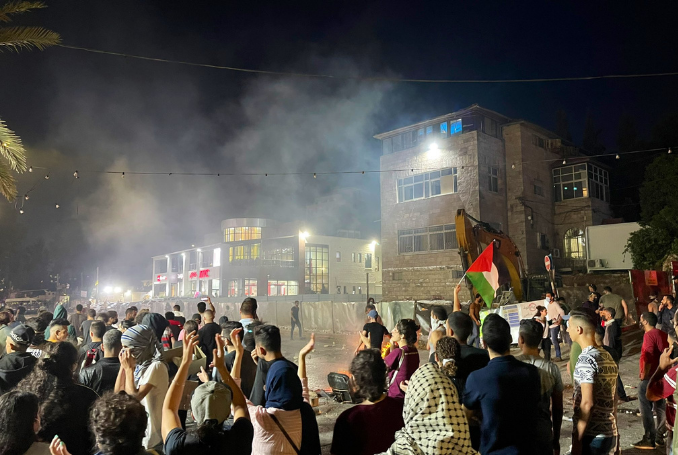 |
June 28, 2021
Following violent aggression against journalists, the Palestinian Journalists Syndicate called on Sunday for national and international mass media to boycott the Palestinian Authority (PA)’s presidency and government.
In a statement, the syndicate called for PA Prime Minister Mohammad Shtayyeh to fire the Palestinian police chief for not affording protection to journalists, banning them from covering the anti-PA protests, and allowing undercover forces to attack them.
The syndicate called for prosecuting the aggressors and asked Shtayyeh to apologize to journalists and to pledge to respect their work and freedom of expression.
If the PA’s aggression on journalists continues, the syndicate warned, other measures would be taken in the meantime.
The syndicate also called for protesters not to harass journalists or undermine their work as “they are merely reporters, not part of the incidents.”
The syndicate asserted that it would start filing criminal complaints against those involved in the attacks against journalists.
(MEMO, PC, Social Media)
Inside Beita’s protests: ‘The settlers didn’t understand who they were dealing with’
For weeks, Palestinians in Beita have been burning tires, shining lasers, and defying army violence day and night to resist an Israeli settlement outpost.
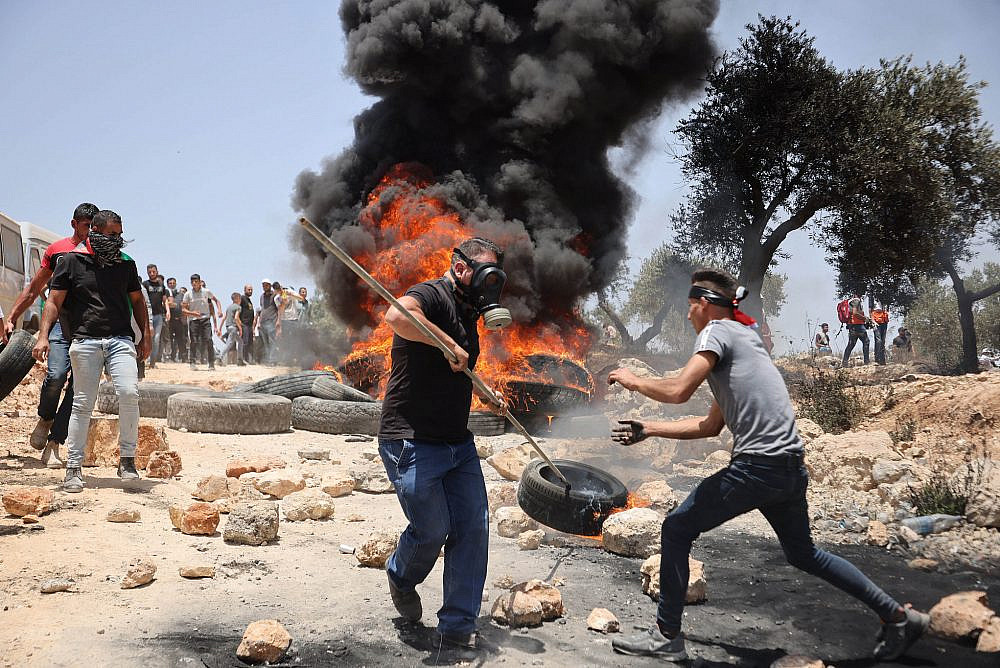
Palestinian protesters burn tires during a protest against the settlement outpost of Eviatar, West Bank, June 11, 2021. (Oren Ziv)
By Oren ZivJune 29, 2021
Over the past few weeks, the town of Beita in the occupied West Bank, home to about 18,000 residents, has become one of the most prominent faces of the Palestinian struggle against Israeli settler land takeovers.
In May, a month after an Israeli was shot dead by Palestinians at the nearby Tapuach Junction, settlers established the outpost of Eviatar on land that belongs to Beita, as well as three other Palestinian villages. The settlers of Eviatar got to work quickly, paving roads and building dozens of structures while receiving protection and even active assistance from the Israeli military.
The outpost was named after Eviatar Borowski, a resident of the nearby settlement of Yitzhar, who was stabbed to death by a Palestinian in May 2013. Settlers have made three different attempts to build an outpost on the site, but the buildings were evacuated very soon after they were erected.
In response, Beita’s Palestinian residents began organizing demonstrations on Fridays, and later nightly protests, against the settlement.
There are over 130 settlement outposts in the occupied West Bank, all of which were established illegally under both Israeli and international law (under the latter, all settlements in the occupied territories are considered illegal). In February 2017, the Knesset passed the “Regularization Law” to retroactively legalize settlements and outposts that are built on land that Israel recognizes as privately-owned by Palestinians. Following its passage, a group of Palestinian local authorities and three human rights organizations petitioned Israel’s High Court to cancel the law.
The law’s implementation has been frozen as part of an agreement between the government and the petitioners until the High Court rules on its constitutionality.
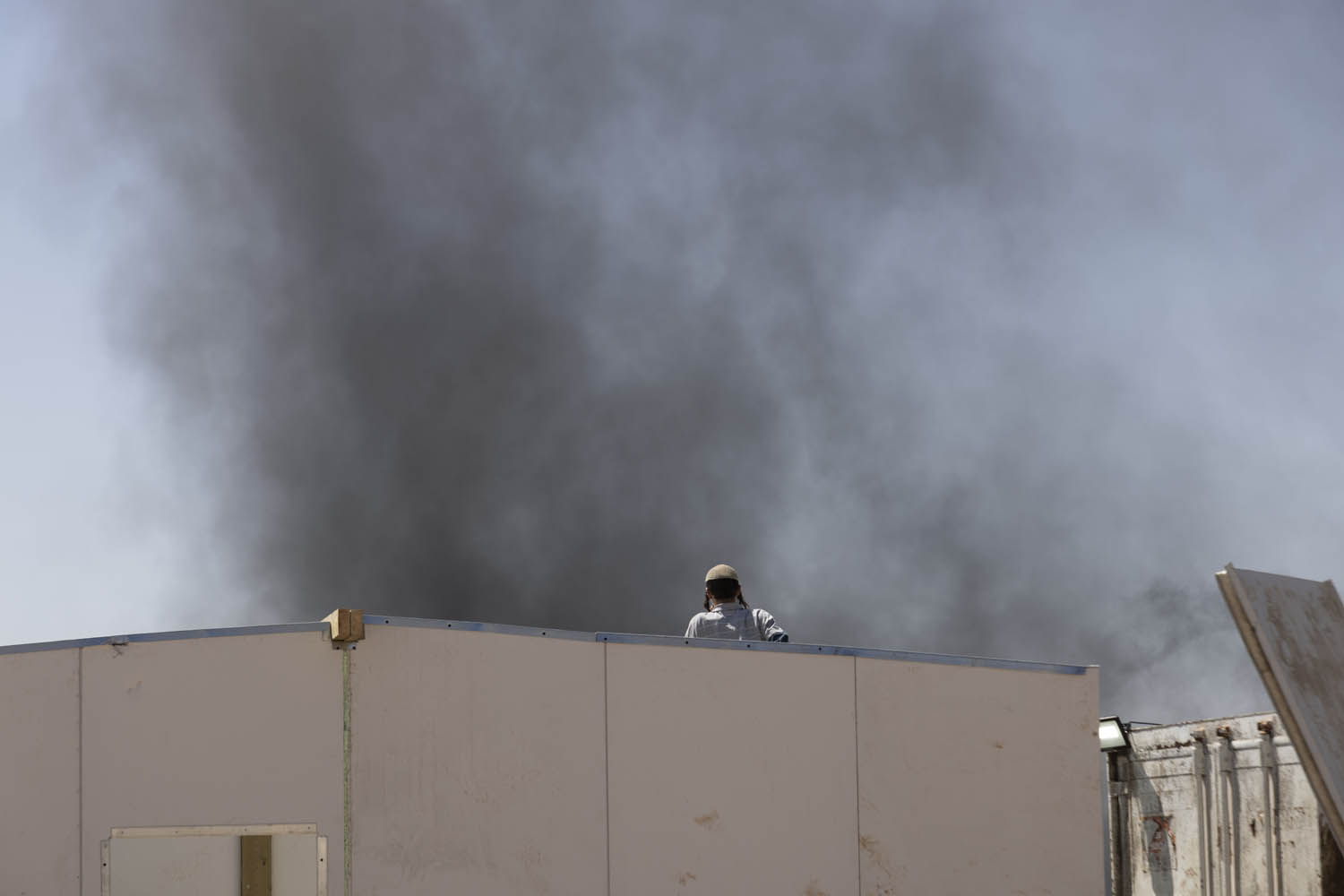
An Israeli settler in the outpost of Eviatar watches as smoke rises from burning tires from the Palestinian town of Beita, West Bank, June 28, 2021. (Oren Ziv)
The demonstrations in Beita this past month have looked and felt like a battlefield: over a thousand residents and workers from other villages protest every week, with Israeli soldiers and Border Police attacking them with tear gas (sometimes fired from a drone), stun grenades, rubber-coated metal bullets, and live “toto” bullets. The army has killed four residents of the town, including 16-year-old Muhammad Hamayel and 15-year-old Ahmad Bani Shams, and has wounded more than 50 people by live ammunition.
The demonstrations in Beita are quite distinct from those that characterized the Palestinian popular struggle against Israel’s separation barrier and settlements during the late 2000s and early 2010s, which have largely waned in recent years. Unlike in other villages in the West Bank, such as Bil’in, the Beita protests are not joint Palestinian-Israeli demonstrations, but clearly Palestinian ones; although individual Israeli activists attend, they do not march alongside Palestinian residents. And compared to most West Bank protests in recent years, Beita’s demonstrations are much larger, more frequent, and more intense.
I joined Beita’s demonstrations over a number of weeks. The following is a chronicle of the town’s resistance and the attempts to suppress it.
Friday, June 4
Around noon, hundreds of cars make their way up a dirt path toward the hills around the Eviatar outpost, which was established on the highest ridge of Mount Sabih. More than a thousand Palestinian protesters — most of them from Beita but also from other villages — gather for Friday prayers on a piece of land that overlooks Eviatar. Once the prayers come to a close, hundreds begin to march in the general direction of the outpost, while others burn tires nearby.
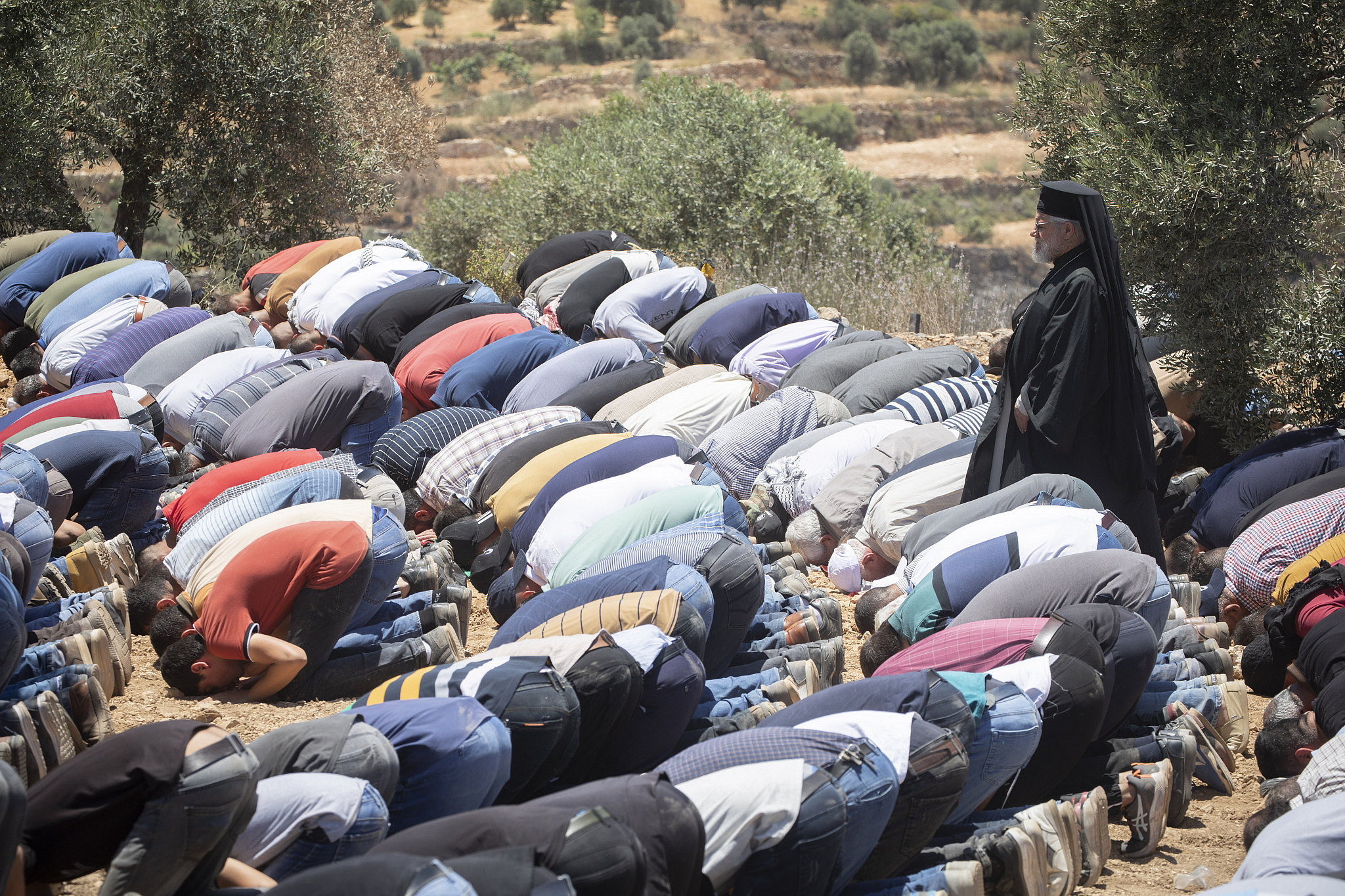
A Palestinian priest who arrived in Beita to show support for the protesters there walks among Muslim worshippers as they pray before their daily demonstration against the Eviatar outpost, West Bank, June 29, 2021. (Oren Ziv)
Within seconds, Israeli soldiers and Border Police officers begin firing massive amounts of tear gas. Many protesters flee backwards, but some of the young people continue to move forward. Then, dozens of meters away from me, protesters begin to hit the ground after being struck by live fire, despite the fact that the demonstrators had not even approached the outpost. While some protesters threw stones, others who did not were shot and then evacuated on foot by local residents to ambulances. Most of them were hit in the leg, but others sustained wounds across their body.
The feeling on the ground is that instead of firing rubber-coated metal bullets, they are now opting for live fire. In general, it seems that since the attack on Gaza and the violence that spread across Israel-Palestine in May, Israeli security forces have been given permission to use live ammunition. A total of 15 protesters were wounded by live fire that day. The demonstration lasted for hours, as young people tried to climb from different directions and reach the main road that leads to the outpost.
Friday, June 11
Arriving at Beita is getting more difficult; the army blocked one of the main entrances to the town following the protests. Some of the entrances from the nearby village of Udala were also blocked with mounds of dirt — a form of collective punishment against Beita’s residents.
This week, protesters gathered for a prayer on the other side of the outpost, above a local quarry. After the prayers, the village youth begin to roll burning tires toward the steep valley, which separates the demonstration from the outpost. After being fired at with tear gas, the protesters scatter to several surrounding hills, throwing stones at the soldiers, who then respond with live ammunition.

A Palestinian demonstrator is carried during a protest against the settlement outpost of Eviatar, Beita, West Bank, June 25, 2021. (Oren Ziv)
In the afternoon, soldiers shoot Muhammad Hamail, a 16-year-old high school student, who dies shortly afterward from his wounds. His school friend, 15-year-old Ahmad Bani Shamsa, will be shot by soldiers several days later, on June 16. He too will die.
Friday, June 18
After the army blocks all major access roads to the town, including the main entrance, the weekly demonstration gathers in front of a new makeshift checkpoint that is guarded by Israeli soldiers 24 hours a day. About a thousand Palestinian protesters pray on the main road. Now they are forced to travel 20 minutes to head out of the town.
Immediately after the prayer, when the march begins, Border Police officers begin throwing stun grenades and tear gas. Many protesters retreat, while dozens of young people remain and throw stones at the soldiers.
This time, perhaps because of the large number of Palestinian deaths caused by their policy over the past month, the soldiers refrain from using live fire. They nonetheless fire rubber-coated metal and sponge bullets in large quantities at the protesters. A number of journalists standing on the side toward the front of the demonstration were wounded and evacuated. Young protesters took large plastic boxes, which are used to transport agricultural produce, from a nearby warehouse and use them as barricades.
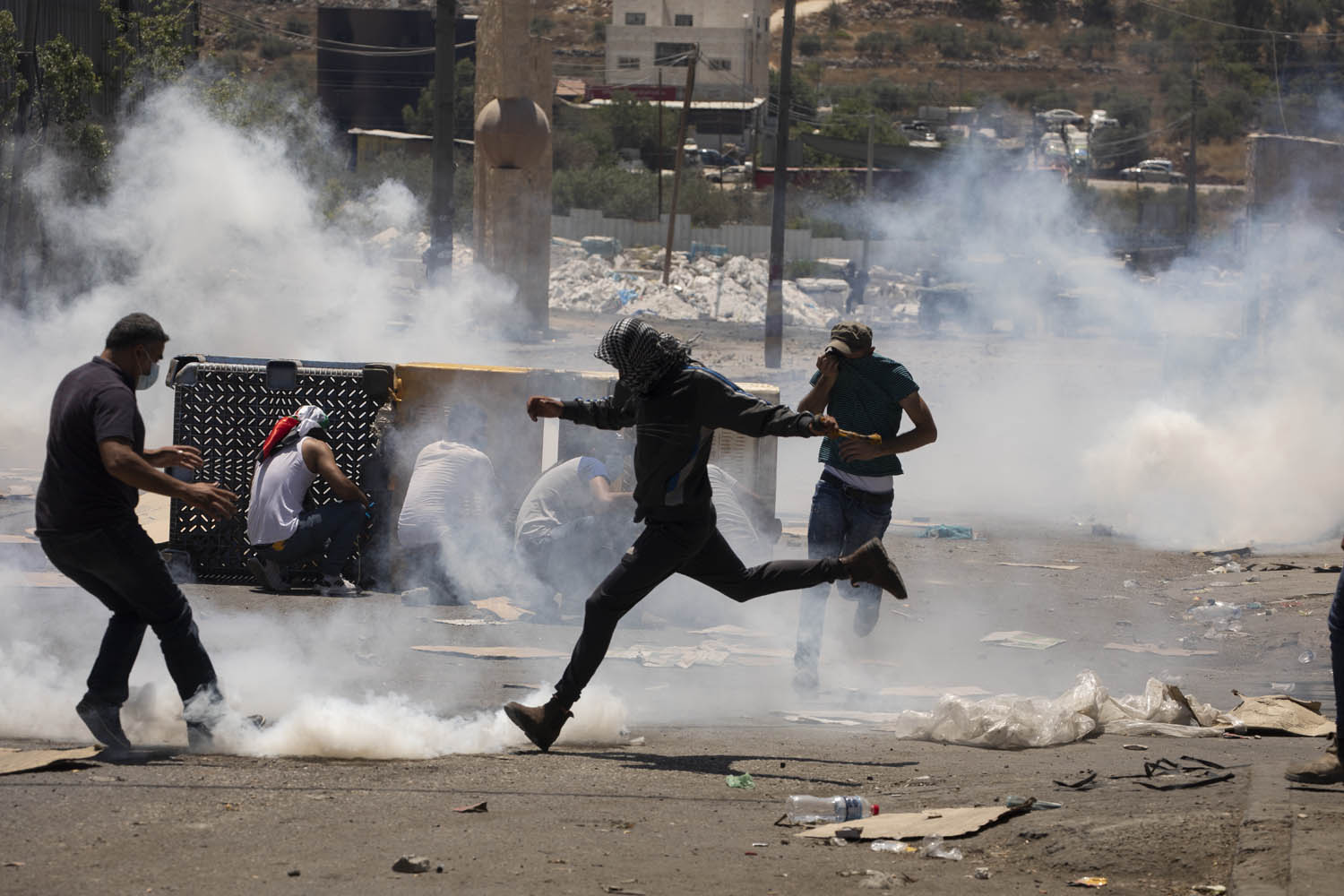
Palestinians throw stones and dodge tear gas shot by Israeli soldiers in the West Bank town of Beita, during a protest against the settlement outpost of Eviatar, June 18, 2021. (Oren Ziv)
Toward the afternoon, the protest moves to the hills around Eviatar. “We will not give up our land. The settlers who established the settlement did not understand who they were dealing with,” says A., a 30-year-old protester.
“This is not a small village, this is a city,” he continued. “We will continue to go out every week until they clear the land and make a beautiful place for recreation or other activities. We cannot accept that they have taken over our house when all this is happening with the help of the army. Without the help of the Israeli forces, [the settlers] would not have stayed there a single day. We would have thrown them out.”
Thursday, June 24
The Beita demonstrations are not limited to daytime hours. Inspired by Palestinian protests at the Gaza-Israel fence, Beita’s residents are operating “units” that burn tires, light bonfires, and shine powerful flashlights and lasers to disturb and deter the settlers. This morning, army forces raided the hills around the outpost, confiscating tires and blocking access roads. The main entrance and the town were open today because Palestinian Prime Minister Mohammad Shtayyeh visited in the morning.
Beita’s residents have been holding these near-nightly demonstrations for the past two weeks. Despite attempts to quell them, hundreds of people regularly gather at sunset on a hill in front of the settlement. Some sit, drink, eat, and pray. In the dark, hundreds of young people descend into the valley and begin to burn tires that the army has not yet confiscated. Others help light the area with flashlights and lasers pointed at the settlement and at the soldiers around it. As opposed to the daylight demonstrations, the soldiers are afraid to move away from the settlement toward the Palestinians, and instead fire tear gas from the nearby terraces.
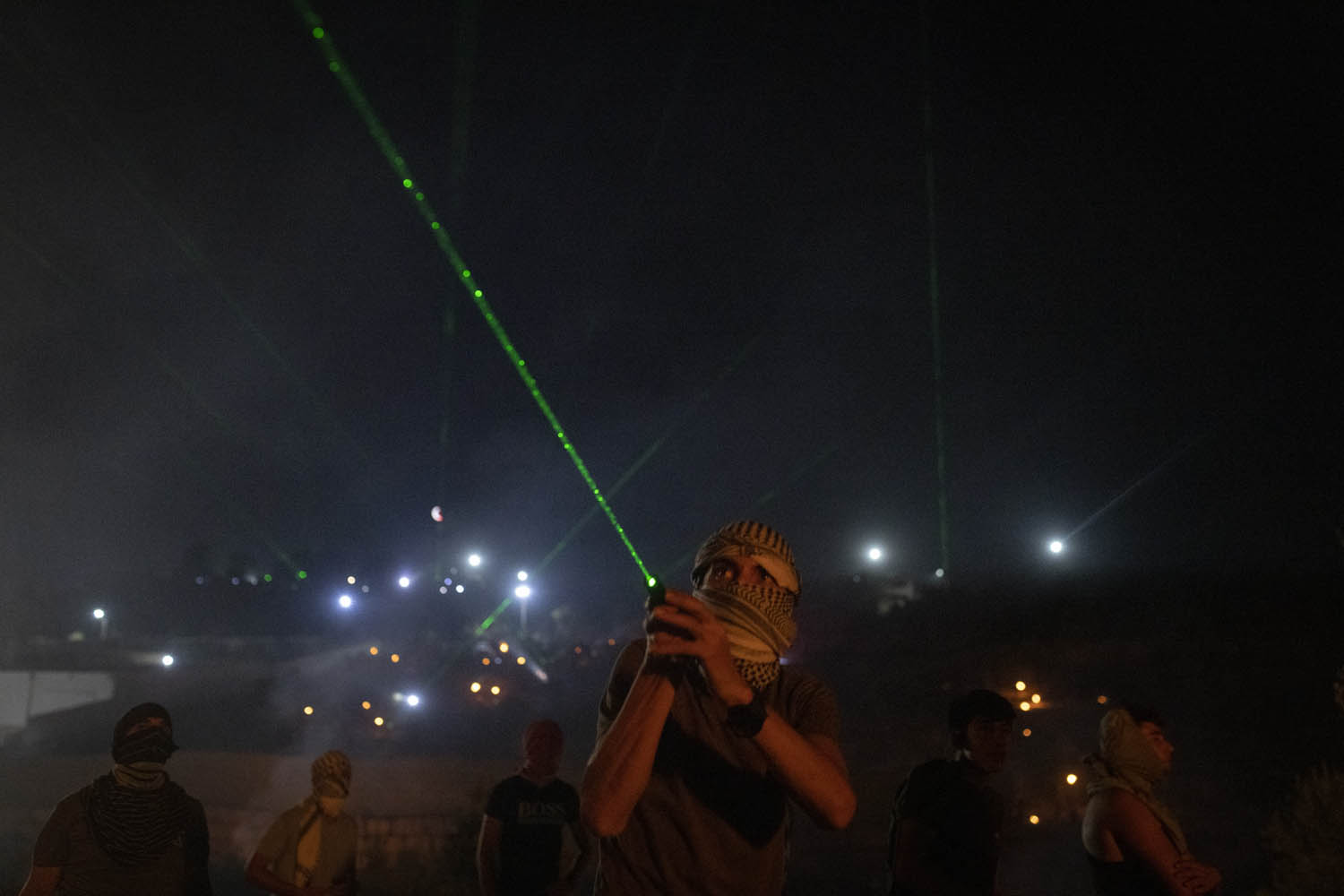
Palestinians shine lasers on the homes of the settlement outpost of Eviatar during a night protest, Beita, West Bank, June 24, 2021. (Oren Ziv)
At around 9 p.m., 200 young Palestinians hold a torchlight procession. Some tear gas grenades cause them to disperse into the hilly terrain.
B., one of the regular Palestinian protesters who holds a flashlight in his hand, says: “They [the settlers] came to stay. When they came they thought [Beita] was a small village, but here everyone goes out to protest, and we understand that the nightly protests are particularly disturbing to them. It’s been like this every night for several days now.”
As we chat, young people pass by and share drinks and homemade food. “This is from the kindness of people’s hearts,” B. says about the food. “People go to grocery stores, buy or cook, and hand out food here to support us. The whole community participates in the protest, each in their own way.”
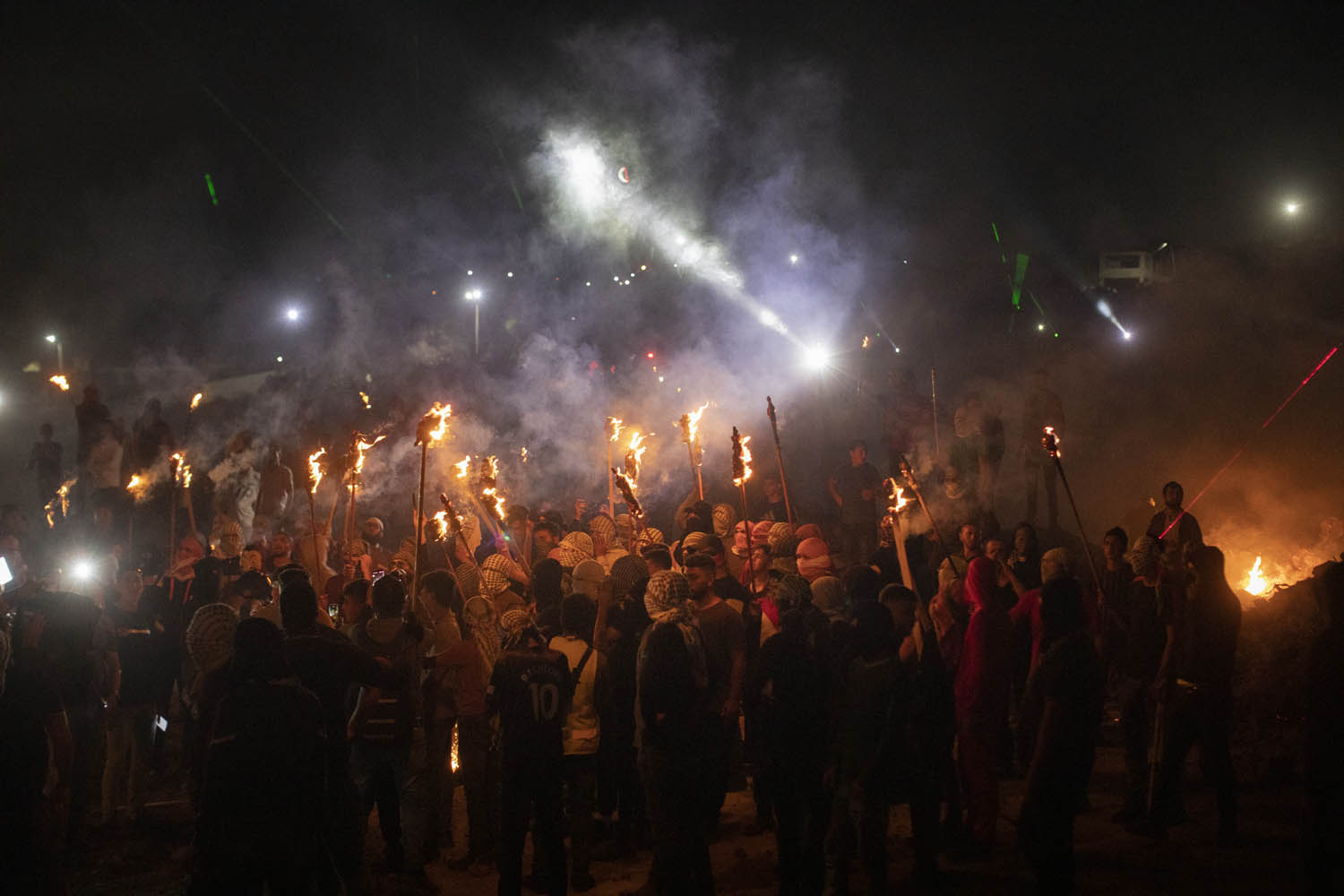
Palestinian demonstrators carry torches during a night protest against the settlement outpost of Eviatar, West Bank, June 11, 2021. (Oren Ziv)
One of the Palestinian adults looks on at the night protest and says, “Why did they [the army] kill the young people who went out to demonstrate? What danger did they pose?” He points to his friend, a 60-year-old man who came to the protest on crutches after being wounded.
“Here the young people are inspired by the adults and vice versa. Everyone goes out to protest. They killed six of our young people here [including two killed last year during a protest against a settler patrol through the village], and people are still continuing to demonstrate.”
Friday, June 25
The protesters gather for prayer in an open area in front of the outpost. But even before the prayer begins, soldiers hiding among the olive trees near the protest shoot tear gas. “Do not throw stones, do not move toward them,” pleads a Palestinian man with a megaphone. “We’ll finish the prayer and then we’ll go to the demonstration.”
The army continues to fire tear gas and dozens of worshipers remain to pray under a cloud of gas, as a medic with a gas mask hands out alcohol wipes, which help deal with the string of tear gas.

An Israeli military jeep fires rounds of tear gas canisters at Palestinian protesters in Beita, West Bank, June 25, 2021. (Oren Ziv)
As soon as the prayer is over, the young Palestinians begin advancing toward the soldiers and throw stones. A military jeep launches tear gas at them, about 20 grenades at a time. The protesters flee everywhere, some fall to the ground and are evacuated by paramedics. Later, an Israeli drone also shoots tear gas at the protesters.
At around 2 p.m., a young Palestinian is hit by live fire and falls to the ground. He is taken by an ambulance to a hospital in Nablus. We later hear that the bullet went into one side of his cheek and came out the other side, causing no severe damage.
The protesters continue to demonstrate. Every once in a while, a Palestinian on a motorized scooter arrives from the direction of Beita carrying water, soft drinks, rice, and cakes. At around 3 p.m. the driver delivers rice and meat to the protesters, who sit to eat under the olive trees.
“Write that this is not a conflict, but occupation and apartheid,” one of the young men demands in English. “American money not only finances the tear gas that is being fired at us, but also the settlement they have built here, the roads, everything. International support allows them to take over our land.”
Monday, June 28
Yossi Dagan, who heads the Samaria Regional Council, announces that the residents of Eviatar have reached an agreement with the state. According to the so-called “compromise,” the settlers and their supporters would leave the area, but the structures will remain in place under the army’s protection. In six weeks, the settlers will be allowed to establish a new yeshiva there.
The state will also review the legal status of the land upon which Eviatar was established in order to potentially formalize it retroactively. Palestinian landowners were not included in the discussions. The deal has yet to be made official, which leaves room for both sides to change their position.
According to Dror Etkes, who heads Kerem Navot, an organization that monitors and researches Israeli land policy in the West Bank, Eviatar was established on land cultivated by Palestinian farmers until the army entered the area in the 1980s, built a makeshift base, and left in the late 1990s.
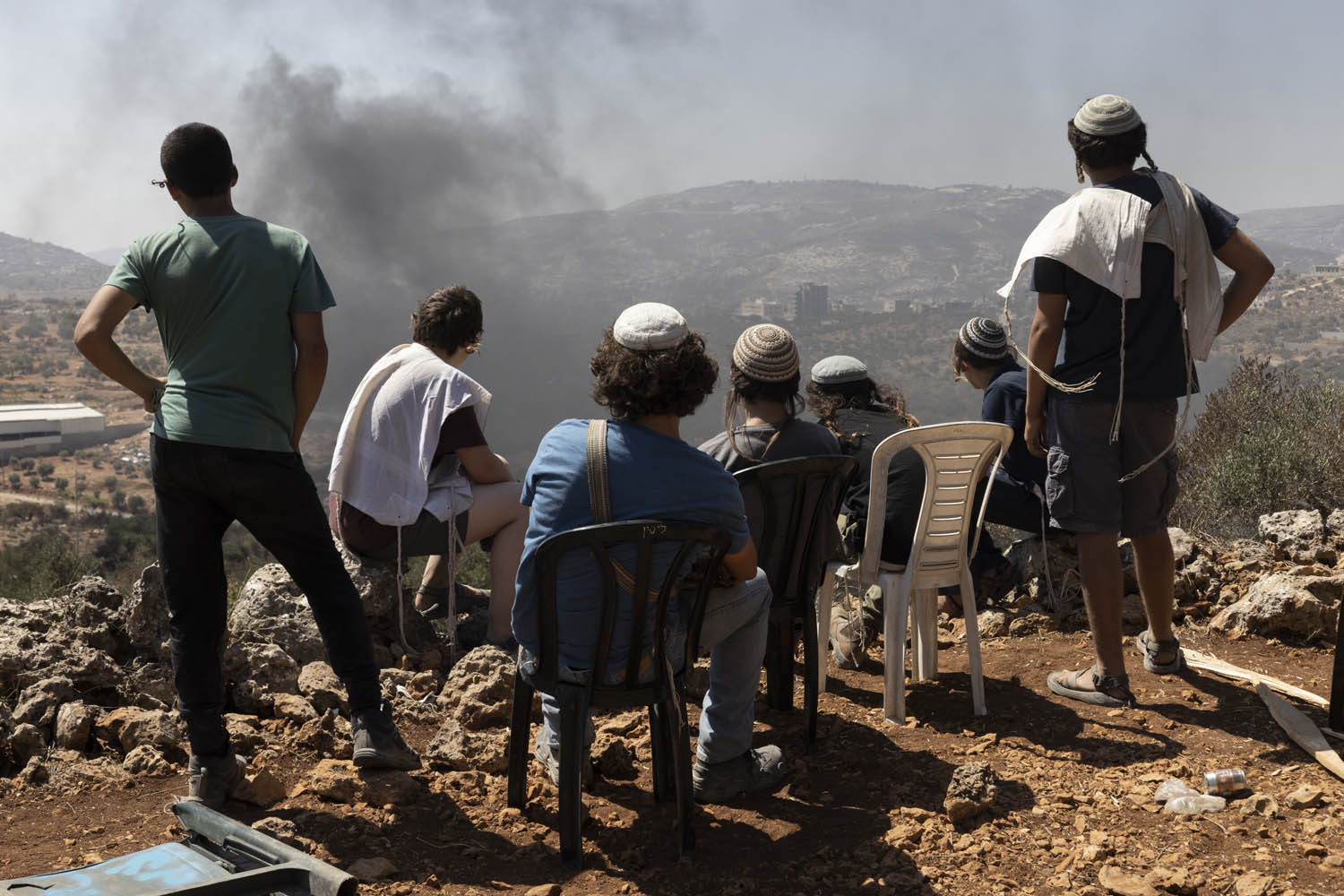
Settler youth in the outpost of Eviatar watch as smoke rises from burning tires near the Palestinian town of Beita, West Bank, June 28, 2021. (Oren Ziv)
The settlers and their supporters, who arrived at the outpost last night in case the army carried out an evacuation, continue with the construction work. Some are clearly energized by the deal and the potential to formalize the outpost; others are less sanguine, fearing their dream will not come true. They pray and dance in the small school they erected, singing “This is our land forever, and we won’t give it to anyone.”
Daniela Weiss, a prominent settler leader and one of the top figures in Gush Emunim, a right-wing religious movement committed to building settlements across the occupied territories that operated in the 1970s, and who helped establish Eviatar, tells journalists at the outpost:
In Gush Emunim, we learned that our job is not to force the government but to elevate the government. Our achievement is that we have pushed the government to reach the situation that it itself wants. Who could have imagined that this government would find a noble and uplifting way to converse without force, but rather out of appreciation for the builders of the land. The achievement is that together we have transcended our daily political bickering. This is a very significant achievement. I learned that from Rabbi Levinger [one of the leaders of Gush Emunim].
In the afternoon, Palestinians begin burning tires, with the wind carrying the smoke toward the settlement. Settlers say that the situation in the area has improved slightly, after soldiers confiscated hundreds of tires near the village last week. Several young settlers stood on the terraces overlooking Beita, alongside two Israeli army reservists stationed at the site. “If the Arabs come, can they be shot?” one of them asked the soldiers. “You can shoot tear gas,” replied one of the soldiers.
Subscribe to:
Posts (Atom)




